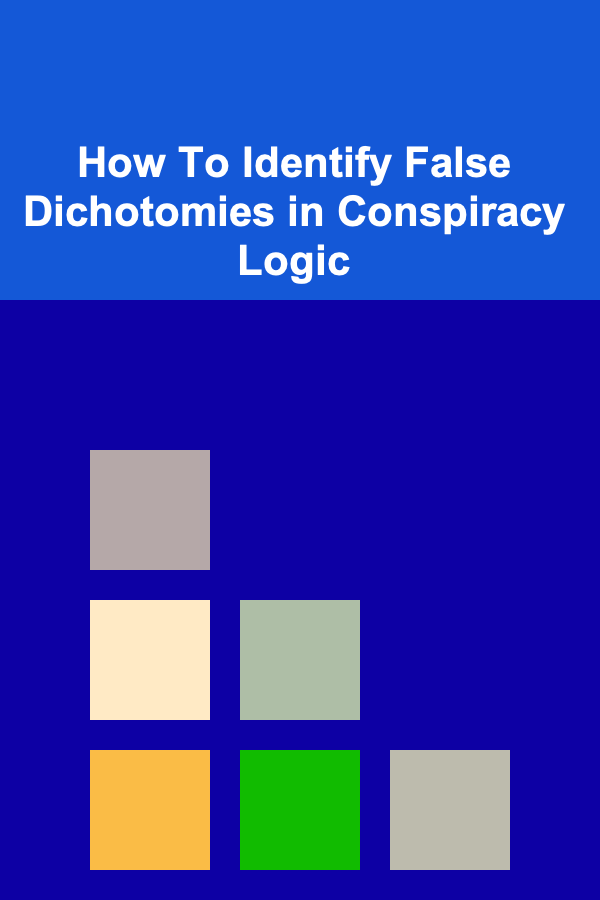
How To Identify False Dichotomies in Conspiracy Logic
ebook include PDF & Audio bundle (Micro Guide)
$12.99$7.99
Limited Time Offer! Order within the next:

Conspiracy theories have been a part of human history for centuries, shaping the way people perceive events and organizations around them. These theories often thrive on the use of logical fallacies, which can cloud judgment and make people believe in irrational and unsupported claims. One such logical fallacy commonly found in conspiracy logic is the false dichotomy or false dilemma.
A false dichotomy is a type of logical fallacy where a situation is presented as having only two possible outcomes or explanations, while in reality, there may be multiple other alternatives. In the context of conspiracy theories, false dichotomies are often used to force the audience into an either-or choice, which simplifies complex issues and manipulates perception. Recognizing and understanding this fallacy can help individuals develop a more critical and nuanced view of the information presented to them.
What is a False Dichotomy?
At its core, a false dichotomy (or false dilemma) is a form of reasoning that presents two extremes and forces a person to choose between them, disregarding any other possible options. This binary thinking distorts the complexity of reality and limits one's ability to see the broader spectrum of possibilities. The fallacy often involves the implication that if one option is false, then the other must be true, ignoring the fact that other options could be equally valid or more reasonable.
In a conspiracy theory context, the false dichotomy works by framing complex events or situations in a way that forces the audience to accept one of two extreme outcomes. This leads to simplified thinking, where the conspiracy is presented as the only logical explanation, and all other possibilities are dismissed as irrelevant or fraudulent.
For example:
- Conspiracy statement: "Either the government is completely transparent about everything, or they are hiding the truth about everything."
- Analysis: This presents an impossible binary, ignoring the possibility that the government could be both transparent in some areas and secretive in others, or that there might be multiple reasons for a lack of transparency.
False dichotomies are especially dangerous in conspiracy theories because they foster an environment where skepticism is channeled in a single direction, preventing critical thinking and the consideration of alternative explanations.
Identifying False Dichotomies in Conspiracy Theories
Identifying false dichotomies in conspiracy theories requires a careful analysis of the logic behind the claims and an awareness of how the theory is being framed. Here are some key indicators to watch for when analyzing conspiracy logic:
1. Exaggeration of Opposing Views
False dichotomies often present opposing views in extreme terms, exaggerating the differences between two sides to create an illusion of a stark choice. This exaggeration is designed to make the conspiracy theory appear more reasonable by comparison, reducing the complexity of the issue to two mutually exclusive options.
For example, a conspiracy theorist might say, "Either the mainstream media tells us the truth, or they are part of a global conspiracy to mislead the public." This framing ignores the possibility that media outlets can sometimes report the truth and sometimes make mistakes, or that some media might have biased reporting without being part of a vast conspiracy.
2. Over-simplification of Complex Issues
Another hallmark of false dichotomies in conspiracy theories is the oversimplification of complex issues. Real-world events are rarely as clear-cut as a binary choice between two extremes. Most situations involve a range of factors, motivations, and outcomes that cannot be neatly packaged into two opposing options.
Conspiracy theorists often reduce multifaceted issues to an overly simplistic binary. For example, when discussing climate change, a false dichotomy might be presented as: "Either global warming is a natural occurrence, or it's part of a conspiracy by scientists to manipulate the public." This reduces the scientific consensus, which recognizes human activity as a significant factor in climate change, to an either-or scenario, which is misleading.
3. Dismissing Other Explanations
False dichotomies typically ignore other plausible explanations that fall outside the two extremes. This selective framing eliminates the opportunity for a nuanced understanding of the topic at hand, pushing the audience to accept one of the two presented options.
For instance, in the case of political conspiracies, someone might argue, "Either the election was entirely rigged, or the results are 100% accurate." This ignores the possibility of electoral flaws, errors, or shortcomings that don't necessarily point to a massive conspiracy but still require attention and correction.
4. Emotional Manipulation
Conspiracy theories that employ false dichotomies often play on the emotions of their audience. By framing an issue as an all-or-nothing scenario, the theory creates a sense of urgency or fear, pushing the audience to take one side and reject any opposing viewpoint.
For example, a conspiracy theorist might say, "If you don't believe in the truth behind this conspiracy, you are supporting the very forces that are trying to destroy freedom and humanity." This type of statement forces people to choose between aligning with the conspiracy or supporting an evil, often vague, enemy. It manipulates emotional responses, discouraging rational discussion or consideration of alternatives.
5. Use of Absolutes
The use of absolute language is a common feature of false dichotomies. Terms such as "always," "never," "all," and "only" are used to describe the two extremes. These absolutes are misleading because they leave no room for exceptions, nuance, or complexity.
For instance, a conspiracy theory might state, "All mainstream news is controlled by elites, and the truth is only available through alternative sources." This rigid dichotomy ignores the diversity of media outlets and the possibility of multiple sources presenting partial truths. It also dismisses the idea that individuals can critically evaluate information from various sources.
Why False Dichotomies Work in Conspiracy Theories
False dichotomies are effective tools for conspiracy theorists because they simplify complex issues and make it easier for people to latch onto extreme, black-and-white thinking. They exploit the natural human tendency to prefer certainty and avoid ambiguity. Conspiracy theories often thrive in uncertain environments, where people feel powerless and are searching for simple answers to complex problems.
Furthermore, false dichotomies are powerful because they create an "us vs. them" mentality. By framing the issue in terms of two opposing sides, conspiracy theories create an emotional divide that encourages people to choose a side. This binary thinking provides a false sense of security, making it easier for individuals to believe they are on the "right" side of the issue, even when the theory itself is logically flawed.
The Appeal of Simplified Narratives
Humans tend to gravitate toward simplified narratives that provide clarity and resolution. Conspiracy theories often offer clear-cut explanations for events that might otherwise be ambiguous or confusing. The false dichotomy provides a sense of certainty in an uncertain world, allowing people to believe that they have uncovered hidden truths that others are too blind to see.
However, the danger of such simplified narratives is that they prevent critical thinking and discourage the consideration of alternative perspectives. Instead of engaging with the complexity of the world, conspiracy theories encourage people to embrace simplistic, binary choices that ignore the gray areas.
Strategies for Counteracting False Dichotomies in Conspiracy Logic
To effectively counteract false dichotomies in conspiracy theories, it is important to approach the information critically and to develop an awareness of the logical flaws at play. Here are some strategies to help identify and challenge false dichotomies:
1. Ask About Alternatives
Whenever you encounter a conspiracy theory that presents an either-or choice, ask yourself: "Are there any other possible explanations?" By actively seeking out alternative perspectives, you can avoid being trapped in the false dichotomy and gain a more nuanced understanding of the issue.
2. Consider the Complexity of the Issue
Real-world problems are rarely simple, and conspiracy theorists often oversimplify complex issues to make them more palatable. Take the time to explore the multiple layers of a situation before settling on one explanation. Consider the role of various factors and how they might interact to create the outcomes in question.
3. Look for Evidence and Reasoning
One of the key ways to evaluate any claim---whether it's a conspiracy theory or not---is to examine the evidence and reasoning behind it. False dichotomies often lack solid evidence and rely on emotional appeals or assumptions. Look for well-supported, reasoned arguments and demand evidence before accepting any explanation.
4. Engage in Constructive Dialogue
Engage in discussions with others about conspiracy theories and encourage open dialogue. By talking through the issue, you can help others see the logical flaws in the reasoning and explore alternative perspectives. Engaging in respectful and thoughtful conversations helps create an environment where critical thinking can flourish.
5. Recognize Emotional Manipulation
Conspiracy theories often rely on emotional manipulation to push people toward a particular conclusion. Be aware of when a theory appeals to fear, anger, or other strong emotions, as these emotional appeals can cloud judgment and make it harder to think critically.
Conclusion
False dichotomies are powerful tools used by conspiracy theorists to manipulate thinking and limit the possibilities for understanding complex issues. By presenting an overly simplistic choice between two extremes, these fallacies distort reality and prevent individuals from exploring alternative explanations. However, by developing critical thinking skills, actively seeking out alternative perspectives, and recognizing emotional manipulation, individuals can avoid falling into the trap of binary thinking and develop a more nuanced, rational understanding of the world around them. Ultimately, awareness of logical fallacies like false dichotomies is a key step toward fostering a more informed and thoughtful society.
Reading More From Our Other Websites
- [Organization Tip 101] How to Create a Workspace for Upcycling Projects
- [Organization Tip 101] Why You Need a Strategy for Managing Kids' School Papers
- [Organization Tip 101] How to Keep Cleaning Supplies Handy Yet Out of Sight
- [Biking 101] How to Choose the Perfect Bike Bell for Your Ride
- [Home Family Activity 101] How to Make DIY Craft Projects for Family Fun
- [Ziplining Tip 101] Behind the Curtain: Engineering the Perfect Water-Crossing Zipline
- [Personal Care Tips 101] How to Use Body Lotion for Smooth, Soft Skin
- [Personal Care Tips 101] How to Use Deodorant to Stay Fresh During Long Travel Days
- [Personal Financial Planning 101] How to Create a Personal Financial Plan for Freelancers
- [Home Pet Care 101] How to Keep Your Pet Hydrated in the Summer

Budget-Friendly and Fun: Top Affordable Family Activities to Try Today
Read More
How to Choose the Right Lighting for Outdoor Spaces
Read More
How to Create Inviting Outdoor Spaces for Staging
Read More
How to Make Your Home Less Appealing to Burglars
Read More
How to Prepare Financially for Parenthood
Read More
Why You Should Regularly Rotate Toys for Child Engagement
Read MoreOther Products

Budget-Friendly and Fun: Top Affordable Family Activities to Try Today
Read More
How to Choose the Right Lighting for Outdoor Spaces
Read More
How to Create Inviting Outdoor Spaces for Staging
Read More
How to Make Your Home Less Appealing to Burglars
Read More
How to Prepare Financially for Parenthood
Read More